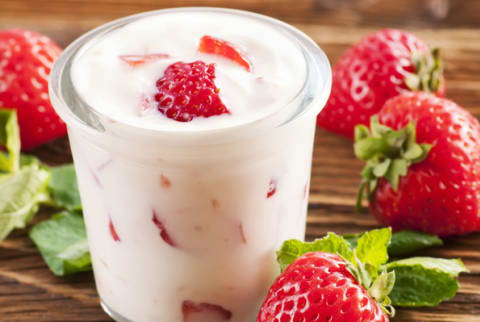Advertisement


Probiotics are the naturally occurring “good” bacteria that live in your gut and play a significant role in your total wellness. When you’re healthy, your intestinal tract hosts over 100 trillion friendly bacteria. (That’s 10 times more than the number of cells in your body!)
These good germs spend their days aiding digestion, boosting the immune system, and consuming bad bacteria. They manufacture key nutrients and limit the growth of yeast and unhealthy bacteria – and in their spare time, probiotics help inhibit bouts of lactose intolerance, poor digestion and diarrhea.
When your “good” bacteria levels are optimal, they outnumber the bad guys by roughly 5 to 1, but take a few gastro-intestinal wrong-turns and the bad bacteria can quickly overwhelm the good, triggering a host of gut problems.
So how to keep your gut functioning at its best?
Get to know the probiotic basics to help your belly – and its 100 trillion good bacteria – flourish!
An unbalanced belly is a sick one
About 70% of our immune system is housed in our gut, so keeping it in good working order is our #1 Job. In a healthy gut, parasites and yeast may be present in small numbers, but don’t cause any problems.
However, when enough of the beneficial bacteria are killed (e.g. with antibiotics), the bad guys (parasites, yeast and bad bacteria) gain the upper hand, causing an imbalance that can manifest itself in a variety of unpleasant ways, including:
- Numerous digestive problems (constipation, colitis, IBS)
- Skin problems (eczema)
- Joint problems (arthritis)
- Altered behavior patterns and brain function
Know the enemy
Without enough good bacteria keeping things in check, your gut will act and feel like a bacterial battleground, with the bad guys running rampant and stirring up debilitating gut troubles such as the ones mentioned above.
And while aging does contribute to declining levels of good bacteria, there are a number of other factors that can wipe out the good guys (no matter your age) and create the perfect environment for the bad bacteria to flourish.
Among the most common killers of our good bacteria:
- Antibiotics – they’re Kryptonite to both good and bad bacteria
- Over-the-counter drugs such as Advil, Motrin and Midol
- Chlorine, found in almost all tap and bottled drinking water
- Virtually all non-organic meat, chicken and dairy, because they’re loaded with antibiotics
- A diet high in meats or fats, which the body is slow to break down, which in turn promotes the growth of harmful bacteria
- Constipation, which allows harmful bacteria to remain in the gut too long and multiply
- Cigarettes, alcohol, junk food and stress
- Radiation and chemotherapy
Enjoy a bowlful of probiotics
For a tasty and easy way to optimize good bacteria, simply increase your intake of fermented foods. Why? Because they contain and deliver a wide variety of good bacteria to the gut, versus processed foods, which have the opposite effect. Miso, tempeh, kim chi, sauerkraut and kefir are great sources.
But what about yogurt?
Many people eat yogurt because they've been told that it’s a good source of friendly bacteria. However, this is not necessarily true. The bacteria used to make most yogurt (L. bulgaricus and S. thermophilus) are not the key beneficial bacteria. Some brands add a small amount of acidophilus just so they can say so on the label.
Plus, much of the yogurt you buy in the store is pasteurized after it is made. This is done to increase the shelf life, but pasteurization destroys all the benefits of the yogurt. So, if you do chose yogurt in the store, make sure the label says “live, active cultures.” And of course, you want to make sure your dairy products have not been produced with antibiotics or hormones.
Send in the probiotic cavalry
To restore your “friendly” bacteria, in addition to eating the fermented foods mentioned above, probiotic supplementation is an extremely effective way to repopulate your gut quickly and return it to a healthy, balanced state.
The two most well researched and commonly used types of healthy bacteria are Lactobacillus and Bifidobacteria, taken in capsule or powder form. The dose for both beneficial bacteria should be 5 to 30 billion viable bacteria a day. Side effects are rare, although probiotic supplementation may at first cause gas and bloating, but the effect usually subsides within a few days. If side effects are bothersome, reduce your dose and then gradually increase it over the course of a week or two.
After the initial phase, I generally advise my clients to continue taking probiotics daily to support optimal health.
The no-prescription, probiotic prescription
When buying probiotics, look for a probiotic blend that delivers the highest number of live organisms to the intestinal tract, and by that I mean at least 5 to 30 billion capsule or teaspoon of powder. Though it may sound like a lot, keep in mind that your gut needs trillions of good bacteria to stay on an even keel, so don’t be put off by the number of zeroes involved!
A good probiotic supplement should also contain a combination of different strains of Lactobacillus and Bifidobacteria. The Be Well Probiotics contain the five most viable and stable strains representing the best-researched bacteria known today. Take the probiotics as directed, once or twice a day, preferably with meals.
Also, keep in mind that due to recent improvements in processing techniques, you don’t need to buy probiotics that require refrigeration – the difference in potency is debatable, and for many people, refrigerated probiotics are too inconvenient to manage.
Bottom line ….
What I love about quality probiotics, is their almost miraculous ability to transform sick people into healthy ones simply, quickly and effectively, without drugs, negative side-effects or, dare I say it, much extra effort.
Just a few inexpensive capsules taken with meals can help prevent and correct debilitating digestive problems such as constipation, diarrhea, colitis and irritable bowel syndrome.
Probiotics produce immunity-boosting chemicals and kill off invading pathogens. They help protect against stomach ulcers, food poisoning, lactose intolerance, yeast overgrowth, yeast infections, harmful bacteria, viruses and fungi.
They even help improve your skin’s health and appearance. How many things can do all that? In short, probiotics offer a massive bang for your health buck – so do all you can to help them flourish!
Have Probiotics worked for you? Please share in your comments.

For Dr. Frank Lipman, health is more than just the absence of disease: it is a total state of physical, mental, emotional, spiritual and social wellbeing. Dr. Lipman is a widely recognized trailblazer and leader in functional and integrative medicine, and he is a New York Times best-selling author of five books, How to Be Well, The New Health Rules, Young and Slim for Life, Revive and Total Renewal.
After his initial medical training in his native South Africa, Lipman spent 18 months working at clinics in the bush. He became familiar with the local traditional healers, called sangomas, which kindled his interest in non-Western healing modalities
In 1984, Lipman immigrated to the United States, where he became the chief medical resident at Lincoln Hospital in Bronx, NY. While there, he became fascinated by the hospital’s addiction clinic, which used acupuncture and Chinese medicine making him even more aware of the potential of implementing non-Western medicine to promote holistic wellbeing.
He began studying nutrition, acupuncture, Chinese medicine, herbal medicine, functional medicine, biofeedback, meditation, and yoga. Lipman founded the Eleven Eleven Wellness Center in 1992, where he combines the best of Western medicine and cutting edge nutritional science with age-old healing techniques from the East. As his patient, chef Seamus Mullen, told The New York Times, “If antibiotics are right, he’ll try it. If it’s an anti-inflammatory diet, he’ll do that. He’s looking at the body as a system rather than looking at isolated things.”
In addition to his practice, he is also an instructor in mbg's Functional Nutrition Program.
More from the author:
Functional Nutrition Training
Check out Functional Nutrition Coaching
A cutting-edge nutrition deep dive taught by 20+ top health & wellness experts
Learn moreMore from the author:
Functional Nutrition Training
Check out Functional Nutrition Coaching
A cutting-edge nutrition deep dive taught by 20+ top health & wellness experts
Learn more
For Dr. Frank Lipman, health is more than just the absence of disease: it is a total state of physical, mental, emotional, spiritual and social wellbeing. Dr. Lipman is a widely recognized trailblazer and leader in functional and integrative medicine, and he is a New York Times best-selling author of five books, How to Be Well, The New Health Rules, Young and Slim for Life, Revive and Total Renewal.
After his initial medical training in his native South Africa, Lipman spent 18 months working at clinics in the bush. He became familiar with the local traditional healers, called sangomas, which kindled his interest in non-Western healing modalities
In 1984, Lipman immigrated to the United States, where he became the chief medical resident at Lincoln Hospital in Bronx, NY. While there, he became fascinated by the hospital’s addiction clinic, which used acupuncture and Chinese medicine making him even more aware of the potential of implementing non-Western medicine to promote holistic wellbeing.
He began studying nutrition, acupuncture, Chinese medicine, herbal medicine, functional medicine, biofeedback, meditation, and yoga. Lipman founded the Eleven Eleven Wellness Center in 1992, where he combines the best of Western medicine and cutting edge nutritional science with age-old healing techniques from the East. As his patient, chef Seamus Mullen, told The New York Times, “If antibiotics are right, he’ll try it. If it’s an anti-inflammatory diet, he’ll do that. He’s looking at the body as a system rather than looking at isolated things.”
In addition to his practice, he is also an instructor in mbg's Functional Nutrition Program.
Watch Next
Enjoy some of our favorite clips from classes
Enjoy some of our favorite clips from classes
What Is Meditation?
Mindfulness/Spirituality | Light Watkins
Box Breathing
Mindfulness/Spirituality | Gwen Dittmar
What Breathwork Can Address
Mindfulness/Spirituality | Gwen Dittmar
The 8 Limbs of Yoga - What is Asana?
Yoga | Caley Alyssa
Two Standing Postures to Open Up Tight Hips
Yoga | Caley Alyssa
How Plants Can Optimize Athletic Performance
Nutrition | Rich Roll
What to Eat Before a Workout
Nutrition | Rich Roll
How Ayurveda Helps Us Navigate Modern Life
Nutrition | Sahara Rose
Messages About Love & Relationships
Love & Relationships | Esther Perel
Love Languages
Love & Relationships | Esther Perel











